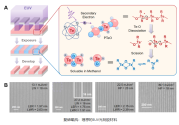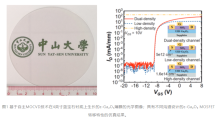Tsinghua University Chemistry team collaborates to develop ideal extreme ultraviolet (EUV) photoresist material
A team from the Department of Chemistry at Tsinghua University has made important progress in extreme ultraviolet (EUV) lithography materials and developed a new photoresist based on polytelluoxane (PTeO), which provides a new design strategy for key materials in advanced semiconductor manufacturing.
As integrated circuit technology continues to advance to 7nm and below nodes, 13.5 nm wavelength EUV lithography has become the core technology for advanced chip manufacturing. However, the characteristics of EUV light sources such as large reflection loss and low brightness have posed higher challenges to photoresists in terms of absorption efficiency, reaction mechanism and defect control. Current mainstream EUV photoresists rely on chemical amplification mechanisms or metal sensitized clusters to improve sensitivity, but they often face problems such as complex structure, uneven component distribution, easy diffusion of reactions, and easy introduction of random defects. How to break through these bottlenecks and build an ideal photoresist system has become the core challenge in the current EUV lithography material field. It is generally believed in academia that an ideal EUV photoresist should have the following four key elements at the same time: 1) high EUV absorption capacity to reduce exposure dose and improve sensitivity; 2) high energy utilization efficiency to ensure that light energy is efficiently converted into changes in the solubility of photoresist materials in a small volume; 3) uniformity at the molecular scale to avoid defect noise caused by random distribution and diffusion of components; 4) as small a building unit as possible to eliminate the influence of primitive feature size on resolution and reduce line edge roughness (LER). For a long time, few material systems have been able to meet all four criteria simultaneously.
The research group has developed a new EUV photoresist based on the polytelluroxane invented by the team earlier, which meets the above conditions of the ideal photoresist. In this study, the team directly introduced the high EUV absorption element tellurium (Te) into the polymer skeleton through the Te─O bond. Tellurium has the highest EUV absorption cross-section except for the inert gas elements xenon (Xe), radon (Rn) and the radioactive element astatine (At). Its EUV absorption capacity is much higher than the short-period elements and metal elements such as Zn, Zr, Hf and Sn in traditional photoresists, which significantly improves the EUV absorption efficiency of photoresists. At the same time, the low dissociation energy of the Te─O bond allows it to directly break the main chain after absorbing EUV, inducing solubility changes, thereby achieving highly sensitive positive development. This photoresist is composed of only a single-component small molecule polymerization, and realizes the integration of ideal photoresist properties under a very simple design, providing a clear and feasible path for building the next generation of EUV photoresists.





